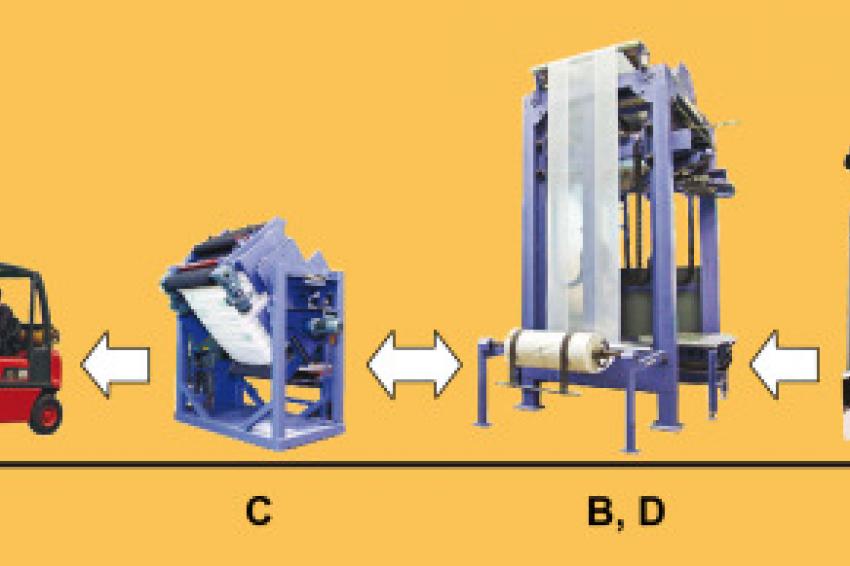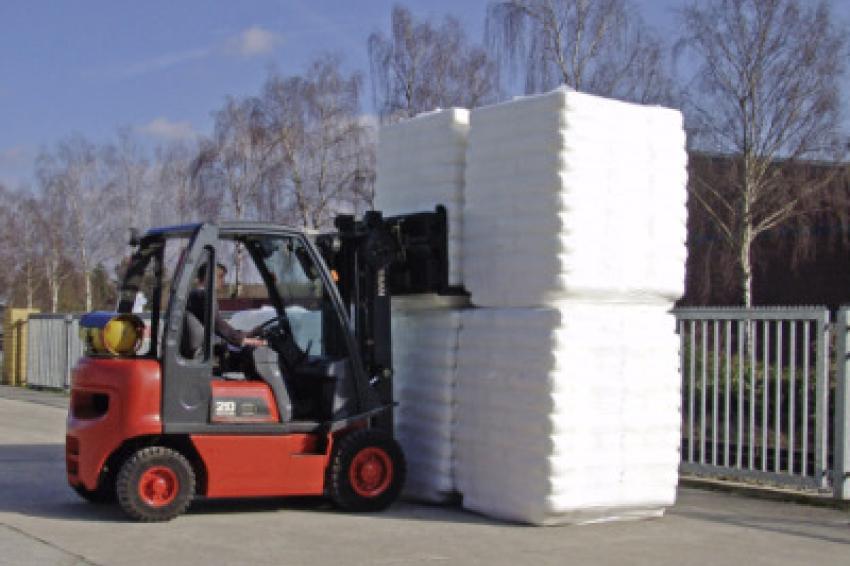Shrink-Wrapped Savings
Polyethylene Film Replaces Transport Pallets
Evolution -The human shoulder was the means of the choice over generations when bags had to be transported. Relief was first felt with the wheelbarrow. And the fork lift brought the pallet, which made the mass flow of goods efficient. The bundling of smaller items on a pallet unit and its handling with fork trucks or cranes is an indispensable basis of today's logistic processes.
But the pallet is a costly logistics tool. Whether they are disposable pallets or reusable ones, pooled pallets or owned by the consignor, the procurement costs are high. Moreover, there are significant costs for transporting and storing empty pallets. Inventory management and pallet repairs involve additional cost, which is often significant.
Another point in view is the functionality of pallets. The pallet is a platform that carries the load stapled on it, nothing more. When pallet loads have to be protected against transport stresses and the elements, additional means such as stretch and shrink hoods have to be used. And where highest economy is asked for, it also matters that the pallet takes up space and payload, which is then not available for the dispatch goods itself.
Pallet Shrink Wrapping: A Base Laying Forerunner
It then comes as no surprise that questions about lowering costs arose soon after the introduction of pallets. The way to the solution came from technology for the transport protection of pallets. Heat-shrinkable plastic films came into use, primarily for general packaging purposes. Later, they also became available in greater thicknesses and with higher strengths for shrinking of pallet loads. Pallet wrapping into shrink film proved to be highly effective and became a common method, even in the chemical industry. Experts in the transport industry called it an "adventurous idea" when engineers of Möllers in Beckum came up with the idea of wrapping the entire dispatch of goods in shrinkable wrap, doing away with the pallet altogether.
Because one of the company's main customer groups is the chemical industry, bags were in the focus of the considerations. The inventors were convinced it must be possible to form the base of the package from the bags instead of the pallet, using film around the stack from all sides.
After two years of development, the "crazy idea" became reality in a new product called the palletless dispatch unit , using the Möllers reverse hood shrink system. The manufacturer delivered some 200 packaging lines to produce the self supporting shipment units. The success could have been much bigger if there not had been an invincible barrier - the heat. In order to shrink properly, the film must be heated for several seconds at temperatures ranging from 150° to 180°. The shrink frames developed for this use worked faultlessly, but in connection with the palletless process, potential customers raised their concerns about the heat and the affect it could have on the goods.
Drastic Cost Reduction Plus Profit For The Environment
In 2009, Möllers launched their new system as a technological breakthrough under the name "Palletless Reverse Hood Stretch Packaging System" and experienced lively response from the industry. In fact, the innovative palletless stretched load has numerous economic and technical advantages, providing significant user benefits. The palletless stretch-wrapped load consists merely of the cargo itself and a polyethylene film sheath. It is formed by wrapping one inner hood of ultra-stretch polyethylene film around the machine-stacked goods, then turning the load through 180° and wrapping an external hood, called the reverse hood. Including a reinforcement sheet made of polyethylene fabrics, it takes just 3 kg of plastic material. Basing on an average price level the materials expenditure is about €6.50 for wrapping a 1.95 ton load; this compares to an average cost of €12 using pallets. Since the palletless load unit wraps the goods tightly as a sealed unit, protecting it from stress in transit and handling, the true comparison is with a pallet plus a stretch hood or shrink hood, which increases the comparative cost to over €14.50. The value of the required foil quantity can sink to about €4 when smaller dispatch units, with less bags and lower total weight are to be made, while the lower weight does not have an effect on the pallet expense. The palletless shrink-wrapped load thus can cut the transport packaging cost by far more than 50%. This doesn't even include costs for handling, transporting and storing the empty pallets as well for pallet repairs.
How Does It Work?
The process to make the stretch wrapped package is simple. On an automatic palletizer, the bags are stacked in layers of, for instance, five bags each. Other layer patterns are possible. The smaller top layer is formed, in this case, of only four bags this way forming recesses on both long sides of the stack. A belt roller conveyor moves the load to the next station, where a sheet applicator places one or two inlays on the stack. The sheets are long enough to form an overhang two or three (depending on the total stack height) bag layers high on all four sides of the stack. On the HSA-Vario transverse stretch hooder, gusseted tubular film is supplied from a reel and reefed onto four stretch fingers, then sealed to the hood along the required length, separated from the tubular film, stretched to the fitting width and drawn over the stack. After this step the package proceeds into the load pressing and turning station which clamps the unit between two belt conveyors and turns it through 180°. Now the former top layer forms the base layer. Once more transported into the HSA-Vario machine the package gets its second hood, called the reverse hood and is ready for dispatch. The core of the innovation on which all of its advantages are founded is the carefully teamed collective of the two hoods and the inlays which ensure the load carrying capacity of the package bottom and protect with their high breakthrough strength the units' base all around.
The Benefits
The technical benefits of the palletless dispatch loads include both the high degree of handling and transport stability of the loads, and the fact that they are completely water tight. This means that even moisture-sensitive materials can be stored in the open, handled and transported on open vehicles in all weathers without further protection. This yields additional savings, such as reduced need for covered storage space, and faster loading and unloading of readily accessible open vehicles. Efficient use of the units is enhanced by ease of load handling due to the convenient handling geometry for cranes and forklifts. By the pallet being dropped, the space utilization is increased to almost 100% in stores and vehicles. When shipping palletless stretched products in containers, one user experienced a plus of 7.2% loaded product weight per container unit. This translated into a savings of 2,740 containers (40 feet) that were no longer required for an annual product volume of 1 million tons. Ensuring quick loading and unloading, the palletless dispatch units fur-thermore offer excellent properties for the direct shipment into ships.
Profitability of the new method presupposes a capacity of the palletless packaging lines sufficient for the running dispatch volumes of the users. The manufacturer corresponds to this claim with a range of lines including three types for throughputs up to 100 stretch wrapped dispatch units per hour. With a possible daily output of far over 1,000 tons of bagged product, such capacity figures are sufficient also for the need of larger manufacturers.
In cooperation with the Dow Chemicals, which applied its Versify elastomer technology to developing the ultra-stretch film, Möllers has invested a significant development effort in this new technology. Now that this system is operational, the benefits of palletless load unitizing have been combined with the benefits of forming loads without applying heat. This in turn provides an important saving in terms of ecology, as the stretch process reduces energy costs by almost 90% compared to the older shrink-wrap system.
Contact
Maschinenfabrik Möllers
Sudhoferweg 93-97
59269 Beckum
+49 2521 88 0
+49 2521 88 100







